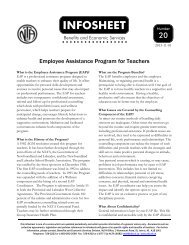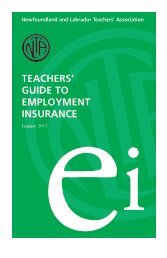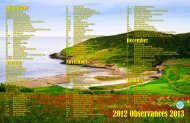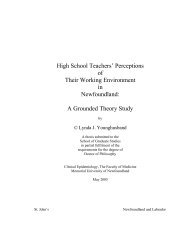The Bulletin, Vol. 40, No. 1 September/October 1996 from the NL ...
The Bulletin, Vol. 40, No. 1 September/October 1996 from the NL ...
The Bulletin, Vol. 40, No. 1 September/October 1996 from the NL ...
- No tags were found...
Create successful ePaper yourself
Turn your PDF publications into a flip-book with our unique Google optimized e-Paper software.
APEF EDUCATION INDICATORS FOR ATLANTIC CANADA REPORTPROVINCIAL HIGHLIGHTSedited by Lesley-Ann Browne"Newfoundland students tend to be more positive about <strong>the</strong>ir schooling than students in <strong>the</strong> Atlantic regionas a whole."Achievement and Attainment<strong>The</strong> overall educational effort aimed at encouraging students to stay in school and improve overalleducation levels in <strong>the</strong> Province appears to have been effective, according to <strong>the</strong> APEF Educators forAtlantic Canada Report. Increases in participation rates, graduation rates and levels of educationalattainment are evidence that efforts to keep students in school are yielding a better educated population inNewfoundland.High school graduation rates in Newfoundland are on <strong>the</strong> increase and rose by seven percentage points to72% between 1990-91 and 1994-95. Graduation rates are still below <strong>the</strong> o<strong>the</strong>r Atlantic provinces, however,<strong>the</strong> rate of increase has been greater than New Brunswick and Prince Edward Island.Indicators <strong>from</strong> <strong>the</strong> School Achievement Indicators Program which tested Reading and Writing (in 1994)and Ma<strong>the</strong>matics Content and Ma<strong>the</strong>matics Problem Solving (in 1993) were reported in this document.Thirteen-year-olds and 16-year-olds were tested.In Reading and Writing, 13-year-old and 16-year-old students in this Province performed at or slightlyabove <strong>the</strong> national average.In Ma<strong>the</strong>matics Content and Problem Solving, 13-year-old students in Atlantic Canada achieved at levelsthat were lower than <strong>the</strong> Canadian average. Newfoundland's performance was similar to <strong>the</strong> o<strong>the</strong>r Atlanticprovinces.For 16-year-olds, <strong>the</strong> average performance of Newfoundland students on <strong>the</strong> Ma<strong>the</strong>matics Content part of<strong>the</strong> test was lower than <strong>the</strong> Canadian average. However, <strong>the</strong>se older students achieved at <strong>the</strong> nationalaverage on <strong>the</strong> Ma<strong>the</strong>matics Problem Solving part of <strong>the</strong> assessment.As measured by <strong>the</strong> 1991 International Assessment of Educational Progress in ma<strong>the</strong>matics and science,students in Newfoundland achieved at levels that were <strong>the</strong> same as <strong>the</strong> international average but slightlylower than <strong>the</strong> national average.ParticipationOver <strong>the</strong> five year period, 1990-91 to 1994-95, <strong>the</strong> participation rates of 16-year-old and 17-year-oldstudents, in Newfoundland, increased by five and seven percent, respectively, and are among <strong>the</strong> highest in<strong>the</strong> country. Among 18-year-olds, <strong>the</strong>re is a substantially higher participation rate for males than for females.While it is positive that more males are remaining in school to complete <strong>the</strong>ir education, this also indicatesthat males are taking longer to complete <strong>the</strong>ir schooling.Students at <strong>the</strong> K-12 Level in this Province have been very successful in progressing through <strong>the</strong> educationsystem in <strong>the</strong> normal 12 year period. Eighty-five percent of graduates in Newfoundland complete <strong>the</strong>irprogram of studies in <strong>the</strong> requisite 12 years compared to only 73% in <strong>the</strong> Atlantic region as a whole. <strong>The</strong>seindicators also show males are taking longer to complete <strong>the</strong>ir schooling than females. Females, in each of<strong>the</strong> Atlantic provinces graduate in <strong>the</strong> normal 12 years at rates that are substantially higher than those of
















